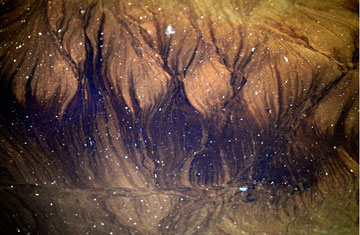
John Warner / Reuters
ExxonMobil has been under a harsh spotlight over the last few days, facing accusations that the company has deliberately downplayed the severity of the Yellowstone River oil spill with misleading information and vague claims about what actually happened. It’s an object lesson in the political risks of owning a pipeline. So the energy company TransCanada would do well to be careful with their next project: the Keystone XL pipeline, a $7 billion pump which will cross the Yellowstone River as it brings crude oil to the U.S. from tar sands developments in Alberta. As TransCanada waits on a permit from the Obama administration this November, this pipeline project is—not surprisingly—facing some opposition from Yellowstone county residents and environmentalists in the wake of the July 1 oil leak.
“Because the size of the pipeline is so much bigger [than the ExxonMobil pipeline], there’s a lot more potential for something to happen and for the spill to be much, much larger,” says Dena Hoff, former chair of the Northern Plains Resource Council and a farmowner in Yellowstone County. The line is sizable: 1,711 miles long, 36 inches wide, and expected to transport up to 700,000 barrels of oil a day. Meanwhile, ExxonMobil’s line is only 70 miles long and 12 inches wide, and it transports just 40,000 barrels a day.
Photos from TIME: Oil Spill on the Yellowstone River
Clearly the biggest concern for the residents is safety, given that many of them earn their livelihood from land that – as the recent spill has showed – can become unworkable if soiled by oil. Hoff wants TransCanada to “not skimp” on essential details such as the thickness of the pipeline and how deep into the ground it is buried, and to be mindful of the environment around the line.
“I’m wanting them to do it right, and not to do it the cheapest possible way,” Hoff said.
Environmental groups, including the Natural Resources Defense Council and the Sierra Club, have argued that conventional pipeline design regulations cannot withstand corrosive tar sands oil carried at high pressure. And Congress has gotten involved as well, with 34 members writing a letter to Secretary of State Hillary Clinton and Environmental Protection Agency Administrator Lisa Jackson in May urging the State Department not to grant a permit for the project until those concerns are addressed.
But this sort of opposition isn’t going to change TransCanada’s plans for Keystone XL, according to company spokesman Terry Cunha.
“Nothing has changed following the incident this weekend,” he said, adding that the company plans to put the pipe 25 feet below the river – at least three times deeper than the ExxonMobil line was below Yellowstone River – and to build it three quarters of an inch thick. Spokesman Shawn Howard has noted in the past that the pipeline will be “the safest ever built,” and will include 16,000 sensors ready to detect the first sign of a leak.
That sounds great—except that TransCanada doesn’t have the greatest track record. At least 12 spills have been reported on its pipelines since May 2010, with the biggest accident occurring this May when about 400 barrels leaked in Sargent County, N. D. due to a valve bursting at a pump station. That’s not very comforting, especially since the May accident blew a 60-foot-high geyser of oil into the air, according to local news reports.
A more fundamental question is whether or not we need the pipeline at all. House Energy and Commerce Chairman Fred Upton recently wrote in Investors Business Daily that the project would create 100,000 jobs and reduce America’s dependence on oil from “hostile nations” by a million barrels a day. Cunha echoed Upton’s case, adding that crude from Canada would ensure a safe supply of oil to the U.S. from a friendly country.
But Hoff isn’t so sure. “I think it’s not going to bring that many jobs to Montana, and certainly not permanent jobs – some of the industries said they will have very few people who will be here once [the pipeline] is in place monitoring it,” she said.
More from TIME: Should the U.S. Be Pumping In Canadian Oil Sands?
We’ll be watching closely as the Obama Administration puts together a final environmental review of Keystone XL. Hopefully that debate will include discussion about what caused the ExxonMobil leak—noting how similar the two pipelines are. If you’re going to be pumping gritty oil at high temperatures and pressures across vital water sources and wildlife habitats, you have to try to get it right. The folks over at Yellowstone County have so much to lose, and they won’t take very kindly to another spill like this one.
Tara Thean is a TIME contributor. Find her on Twitter at @TaraThean. You can also continue the discussion on TIME‘s Facebook page and on Twitter at @TIME.
More from TIME: Why Gas Pipelines are like Facebook


